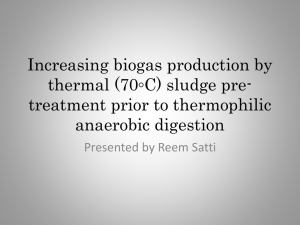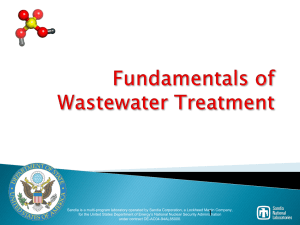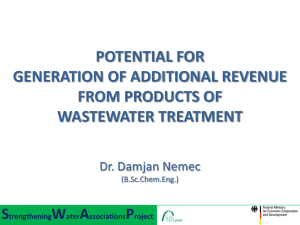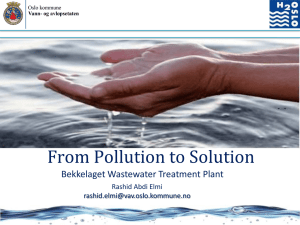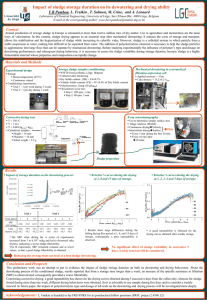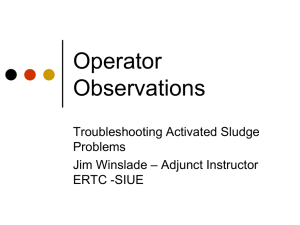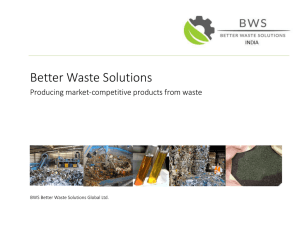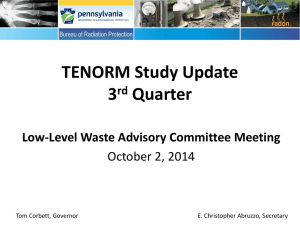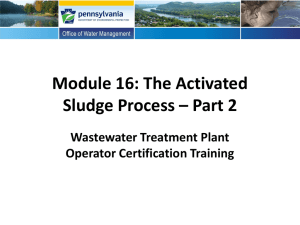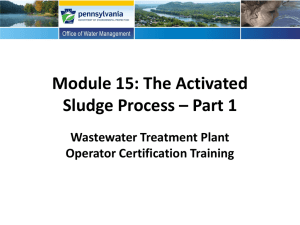Pre-treatment of sludge
advertisement
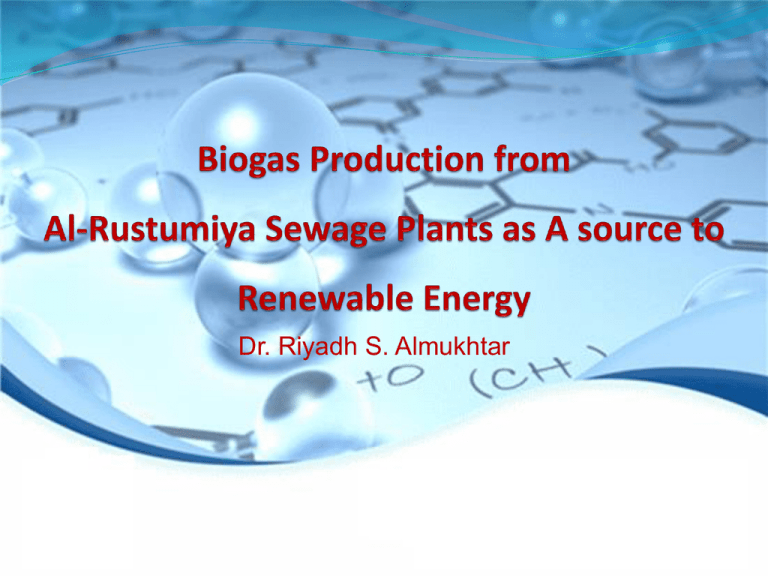
Dr. Riyadh S. Almukhtar Anaerobic Digestion (AD) Anaerobic Digestion (AD) is the consequence of series metabolic interactions among various groups of microorganisms. It occurs in three stages: Hydrolysis, Acidogenesis Methanogenesis. Anaerobic Digestion (AD) Anaerobic Digestion (AD) Energy equivalents 1 Watt = 1 joule second-1 1 Wh = 1 x 3600 joules (J) 1 kWh = 3600000 J 1 kWh = 3.6 MJ 22 MJ (1m3 biogas) = 22/3.6 kWh = 6.1 kWh Electrical conversion efficiency = 35% Therefore 1m3 biogas = 2.14 kWh (elec.) Anaerobic Digestion (AD) Before Biogas is Used Removal of Contaminants Moisture and particulates in all recovery processes • Inefficient combustion, blocked nozzles • Reduced by condensers, filters Hydrogen sulfide in most recovery processes • In presence of moisture, forms sulfuric acid, which causes corrosion Municipal Waste Water Treatment The sludge that produced in municipal wastewater treatment plants seems to be problems in some countries while in other countries it recognized as a source of power and they utilized it in environmental friends rather than harming the environment Municipal Waste WaterTreatment Stages 1. primary sedimentation. Solid-water suspension is partially separated in conical tanks 2. Secondary Treatment (biological )The dissolved solids and fine particles that don’t settle in primary sedimentation are treated by aerobic bacteria. These microorganisms using the oxygen for oxidation of solid particles and convert them to perceptible solids in aeration tank. Municipal Waste Water Treatment Stages The solids that produced in last step (sludge + aerobic bacteria) are deposited secondary sedimentation. Some of activated sludge returned to aeration tank and the waste is mixed with primary sludge then fed to thickener basins. The aim of thickening is decreasing of sludge volume up to 30% by dewatering. Primary sludge Primary is also called raw sludge which comes from the bottom of the primary clarifier. Primary sludge is easily biodegradable since it consists of more easily digestible carbohydrates and fats, compared to activated sludge which consists of complex carbohydrates, proteins and long chain hydrocarbons (Gray et al., 2007). So biogas is more easily produced from primary sludge. Municipal Waste WaterTreatment Stages Activated sludge Activated sludge is also called excess sludge or waste activated sludge which comes from the secondary treatment. It‘s a result of overproduction of microorganisms in the activated sludge process. The content of activated sludge was just mentioned above. Activated sludge is more difficult to digest than primary sludge. Al-Rustumiya plant Al-Rustumiya plant is one of the biggest sewage treatment plants in Iraq. It is divided to North and South plant. It had been established different time, the first plant called Zero established in 1962 and since then many additional plants had been added through seventh and eighteenth of last century. Al-Rustumiya plant Al-Rustumiya plant (both North and South) is dealing with about 650,000 (m3 /day) of wastewater and serve round about 3,000,000 persons. Unfortunately Al-Rustamiyah plant doesn’t use anaerobic digestion for produced sludge where the sludge go directly to drying beds to dry and then it sold as a fertilizer Accum ilated biogas production (m l) 600 500 400 300 200 100 0 0 2 4 6 8 Tim e, day 10 12 14 16 Pre-treatment of sludge Chemical: For alkaline pre-treatment 3liters of sludge sample filled the three beakers (1 liter capacity) and pH values of samples were set at 9, 10 and 11 respectively, by addition of 10N sodium hydroxide (NaOH). The beakers were mechanically stirred at 250(rpm) for 2(hr). After alkaline pre-treatment, the hydrochloric acid (HCl) solution of 10N was added to set the pH at optimum level (pH of 7). Pre-treatment of sludge 2200 2000 ch e m ica l p H =9 ch e m ica l p H =1 0 A c cu m ila te d b io g a s p ro d u c tio n (m l) 1800 ch e m ica l p H =1 1 1600 1400 1200 1000 800 600 400 200 0 -2 0 0 0 2 4 6 8 10 12 14 16 Figure: Accumulated biogas after chemical pre-treating. T im e , d a y Pre-treatment of sludge 1000 o 60 C . Accum ilated biogas production (m l) o 80 C 800 600 400 200 0 0 2 4 6 8 Tim e, (day) 10 12 14 16 Pre-treatment of sludge 2400 . . Accum ilated biogas production (m l) 2200 2000 1800 1600 1400 1200 1000 800 600 400 200 0 0 2 4 6 8 Tim e, (day) 10 12 14 16 3500 C ontrol o Accumulated Biogas Production, ml 3000 2500 Therm al T= 80 C U l t r a s o n ic 3 0 k H z C h e m ica l p H = 1 1 T h e r m o - C h e m ic a l Figure : Accumulated biogas after different pre-treatment process. 2000 . 1500 1000 500 0 Pre-treatment of sludge According to figure higher biogas volume was achieved by 30 KHz pre-treating frequency which was (3209ml) after 14 days of digestion in the next, thermo-chemical pre-treating pH (11) +80 accumulate a (2298ml) volume of biogas followed by chemical pre-treating pH (11) which was (2028ml) and finally 80 thermally pre-treated sludge resulted in (949ml) of total biogas production Pre-treatment of sludge while the lower volume of biogas was recorded for control (blank test) digestion which was (509ml). The percentage increasing of biogas by 30 KHz was (530.45%), pH (11) +80 (351.47%), pH (11) (298.43%) and 80 (86.45%) comparing to control digestion (blank test). Conclusions:Arrangement of improvement efficiencies of on biogas production Ultrasonic 30 KHz > Thermo-chemical pH (11) + 80 > Chemical pH (11) > Ultrasonic 50 KHz > Chemical pH (10) > Thermal 80 > Thermal 60 > Chemical pH (9) > Control (blank test) Conclusions: Anaerobic digestion was very appropriate to Iraqi warm weather to reduce as much as possible of daily accumulated sludge in Al-Rustumiya WWTP in addition to decreasing of emitted bad odors and to generate electricity to overcome the shortage Al-Rustumiya plant We believe that it is important to use A D units in Al- Rustumiya plant for many reasons 1. Power generation from biogas produced can cover the plant capacity requirements ( less dependency on national generation system) 2. Sludge without A D still had different types of pathogens which effects on farmer live or vegetable consumers For employees and neighborhoods health because active organic matter can attract disease carrying vectors such flies beside the bad odors energy recovery from sewage sludge decrease the need of fossil oil and decrease the environmental impact of global warming THE END
